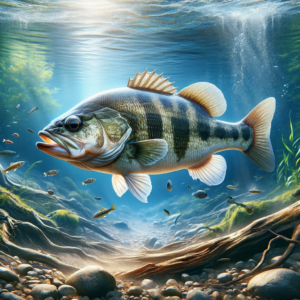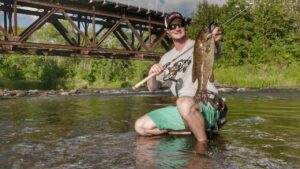Do you ever wonder what smallmouth bass do when the sun goes down? Well, one intriguing question that often comes up is whether or not smallmouth bass eat at night. It’s a fascinating topic that has caught the attention of many anglers and fish enthusiasts. In this article, we will delve into the behavior of smallmouth bass during the nighttime and explore their feeding habits in detail.
When the darkness blankets the water, smallmouth bass undergo a transformation in their behavior. While they are primarily diurnal, meaning they are most active during the day, smallmouth bass have been observed feeding during the night as well. It has been found that they are opportunistic feeders, taking advantage of their environment to find prey. This adaptability allows them to adjust their feeding patterns to different conditions, and nighttime presents new opportunities for them to hunt and feed.
Research has shown that smallmouth bass have a keen sense of sight and are capable of hunting in low-light conditions. Their eyes are specialized to gather as much available light as possible, allowing them to see and target their prey even in the dark. Additionally, smallmouth bass possess a lateral line system, a series of sensory organs along their sides that can detect vibrations and movements in the water. This enables them to sense the presence of prey, even if visibility is limited.
In conclusion, smallmouth bass do eat at night. While they are primarily active during the day, they are opportunistic feeders that can adapt to different conditions. Their keen eyesight and lateral line system allow them to target and capture prey in low-light environments. So, if you’re planning a nighttime fishing excursion, don’t count out the possibility of catching a smallmouth bass. Just remember to bring your patience and a good flashlight!
Introduction
When it comes to fishing for smallmouth bass, understanding their feeding habits is essential. One common question that often arises is whether smallmouth bass feed at night. In this article, we will explore the feeding behavior of smallmouth bass, particularly focusing on their nocturnal feeding habits. By understanding the factors influencing their feeding behavior, anglers can improve their fishing techniques and increase their chances of success.
Smallmouth Bass Feeding Habits
Feeding Patterns
Smallmouth bass are predatory fish known for their voracious appetites. They possess a wide range of feeding patterns depending on various factors such as water temperature, light conditions, and prey availability. Their feeding patterns can vary from being highly active during the day to predominantly feeding at night.
Preferred Prey
Smallmouth bass have a diverse diet and will consume almost anything that they can fit into their mouths. However, they do have a preference for certain types of prey. Small fish such as minnows and shad are commonly sought after by smallmouth bass. Additionally, crayfish, insects, and other aquatic invertebrates are also a staple food source for these fish.
Factors Affecting Feeding Behavior
Several factors influence the feeding behavior of smallmouth bass. One of the key factors is the availability of prey. Smallmouth bass are opportunistic feeders and will adjust their feeding patterns based on the abundance or scarcity of food in their environment. Water temperature, moon phase, and water clarity are other crucial factors that can affect their feeding behavior. Understanding these factors can help anglers predict when and where smallmouth bass are most likely to feed.
Nocturnal Feeding Behavior
Evidence of Nocturnal Feeding
Numerous studies and angler observations have provided evidence of smallmouth bass engaging in nocturnal feeding behavior. Anglers have reported successful catches during nighttime fishing trips, which further supports the notion that smallmouth bass are active feeders after dark. Additionally, studies have shown an increase in stomach content during the nighttime hours, indicating that smallmouth bass do indeed feed at night.
Reasons for Nocturnal Feeding
There are several reasons why smallmouth bass engage in nocturnal feeding. One reason is reduced competition from other predators. During the day, smallmouth bass have to compete with other fish species and predators for food. However, at night, when most other fish are less active, smallmouth bass have a competitive advantage and can feed without much interference.
Another reason for nocturnal feeding is the availability of prey. Many prey species, such as crayfish and insects, become more active and vulnerable during the night. This increased activity provides smallmouth bass with more opportunities to hunt and feed on their preferred prey.
Adaptations for Nighttime Feeding
Smallmouth bass have developed specific adaptations that enable them to effectively feed at night. One of these adaptations is their excellent low-light vision. Their large eyes and tapetum lucidum, a reflective layer behind the retina, enhance their ability to see in low-light conditions. This gives them a significant advantage in locating and capturing prey during the night.
Furthermore, smallmouth bass have a highly sensitive lateral line system, which allows them to detect slight water movements and vibrations. This sensitivity aids them in locating prey in the darkness and improves their accuracy in striking their target.
Feeding Mechanisms
Ambush Predation
One of the feeding mechanisms employed by smallmouth bass is ambush predation. They are skilled at patiently waiting in cover, such as rocks, weed beds, or submerged logs, and then striking at unsuspecting prey as it swims past. This method is particularly effective when smallmouth bass are feeding at night, as the reduced visibility allows them to surprise their prey more easily.
Bottom Foraging
Smallmouth bass also engage in bottom foraging, especially during the night. They use their sensitive lateral lines to detect prey hiding in the substrate, such as crayfish and other bottom-dwelling organisms. By rooting through the sediments, smallmouth bass can find and consume these prey items, even in low-light conditions.
Surface Feeding
Although smallmouth bass predominantly feed near the bottom, they also exhibit surface feeding behavior. This is especially true during low-light conditions, including nighttime. Smallmouth bass will actively seek out insects, such as mayflies or grasshoppers, that are resting or flying close to the water’s surface. This provides anglers with opportunities to target smallmouth bass with topwater lures or flies during the night.
Benefits of Nighttime Feeding
Reduced Competition
One of the significant advantages of smallmouth bass feeding at night is the reduced competition for food. Many other fish species, including their predators, are less active during the night. This decreased activity allows smallmouth bass to have more opportunities to feed without having to compete with other fish for the same prey.
Prey Availability
Nocturnal feeding allows smallmouth bass to take advantage of high prey availability during the night. Many aquatic insects and bottom-dwelling organisms become more active and vulnerable after dark. This increased prey activity provides smallmouth bass with a constant source of food, ensuring their survival and growth.
Environmental Factors
Water Temperature
Water temperature plays a significant role in the feeding behavior of smallmouth bass. They are ectothermic, meaning their body temperature depends on their surrounding environment. Smallmouth bass are most active and feed more frequently when the water temperature is within their ideal range, typically between 65 to 75 degrees Fahrenheit. At night, when water temperatures may cool down, smallmouth bass can become more active, making it an optimal time for fishing.
Moon Phase
Moon phase can also influence the feeding behavior of smallmouth bass. Many anglers believe that during a full or new moon, fish become more active and aggressive due to increased light and visibility. Conversely, during a quarter or half moon, smallmouth bass may exhibit reduced feeding activity. However, further research is needed to fully understand the exact relationship between moon phase and smallmouth bass feeding behavior.
Water Clarity
Water clarity is another environmental factor that can affect smallmouth bass feeding behavior. In clear water, smallmouth bass can rely more on their vision to locate prey. However, in murky or stained water, they may rely more on their lateral line system to detect prey movements. Understanding the water clarity of a particular fishing location can help anglers choose the most effective fishing techniques.
Feeding Activity throughout Seasons
Spring
In spring, smallmouth bass become more active as the water temperature starts to rise. They begin feeding more frequently to support their increased energy needs. Smallmouth bass are more likely to feed during the day in spring, but nighttime feeding can also be productive. As the water warms up and prey becomes more abundant, smallmouth bass become more active during the night as well.
Summer
Summer is a prime feeding season for smallmouth bass. With warmer water temperatures and an abundance of prey, smallmouth bass will feed throughout the day and night. However, during the hottest parts of the day, they may seek deeper, cooler areas and become less active. Fishing during the early morning or late evening can be particularly rewarding during the summer months.
Fall
Fall is another productive season for smallmouth bass feeding. As the water begins to cool down, smallmouth bass become more active and will feed heavily to prepare for the upcoming winter months. During fall, they may exhibit increased feeding activity during the day, but nighttime feeding can still yield successful catches.
Winter
Winter poses more challenging conditions for smallmouth bass anglers, as the colder water temperatures significantly slow down their metabolism. Smallmouth bass may feed less frequently during the winter months, and daytime feeding becomes more common. However, there are still opportunities for nighttime feeding, especially during periods of milder weather or in areas with warmer water discharges.
Research and Studies
Scientific Findings
Several scientific studies have been conducted to understand the feeding behavior of smallmouth bass. These studies have provided insights into their dietary preferences, feeding patterns, and factors that influence their feeding behavior. Researchers have used techniques such as stomach content analysis, underwater cameras, and tracking studies to gain a better understanding of smallmouth bass feeding habits.
Observations from Anglers
Anglers who have spent countless hours on the water have also made valuable observations about smallmouth bass feeding behavior. Their firsthand experiences can provide practical insights into when and where smallmouth bass are most likely to feed. Anglers often document successful catches during nighttime fishing trips, suggesting that smallmouth bass are indeed active feeders after dark.
Fishing Techniques for Nighttime Bass
Choosing the Right Lure
When fishing for smallmouth bass at night, it is crucial to choose the right lure. Dark-colored lures or those with rattling or vibrating features can be highly effective in low-light conditions. Topwater lures such as buzzbaits or poppers can also elicit explosive strikes from smallmouth bass. Matching the size and profile of the lure to the natural prey in the area can further increase the chances of success.
Casting Techniques
Nighttime fishing for smallmouth bass often requires precise casting techniques. Casting into specific areas, such as rocky structures, submerged vegetation, or undercut banks, can increase the chances of attracting a strike. It is essential to cast quietly and avoid causing excessive disturbances in the water, as smallmouth bass rely on their sensory perception to locate prey in the darkness.
Nighttime Fishing Gear
When fishing for smallmouth bass at night, certain gear considerations can enhance the angling experience. A headlamp or light source with a red LED can be useful for navigating in the dark without spooking the fish. High-visibility fishing line or fluorescent line can help detect subtle strikes during nighttime fishing. Additionally, having a properly equipped and organized tackle box ensures that the necessary lures and tools are easily accessible during nighttime fishing trips.
Conclusion
In conclusion, smallmouth bass do eat at night. While they are primarily daytime feeders, smallmouth bass exhibit nocturnal feeding behavior under certain conditions. Understanding the factors that influence their feeding behavior, such as reduced competition, prey availability, and environmental factors, can greatly improve anglers’ success rates. Employing the right fishing techniques, choosing the appropriate gear, and being aware of the feeding activity throughout the seasons will enable anglers to maximize their chances of catching smallmouth bass during nighttime fishing trips. So, the next time you hit the water after dark, keep in mind that smallmouth bass may just be lurking in the shadows, ready to strike at your lure.




